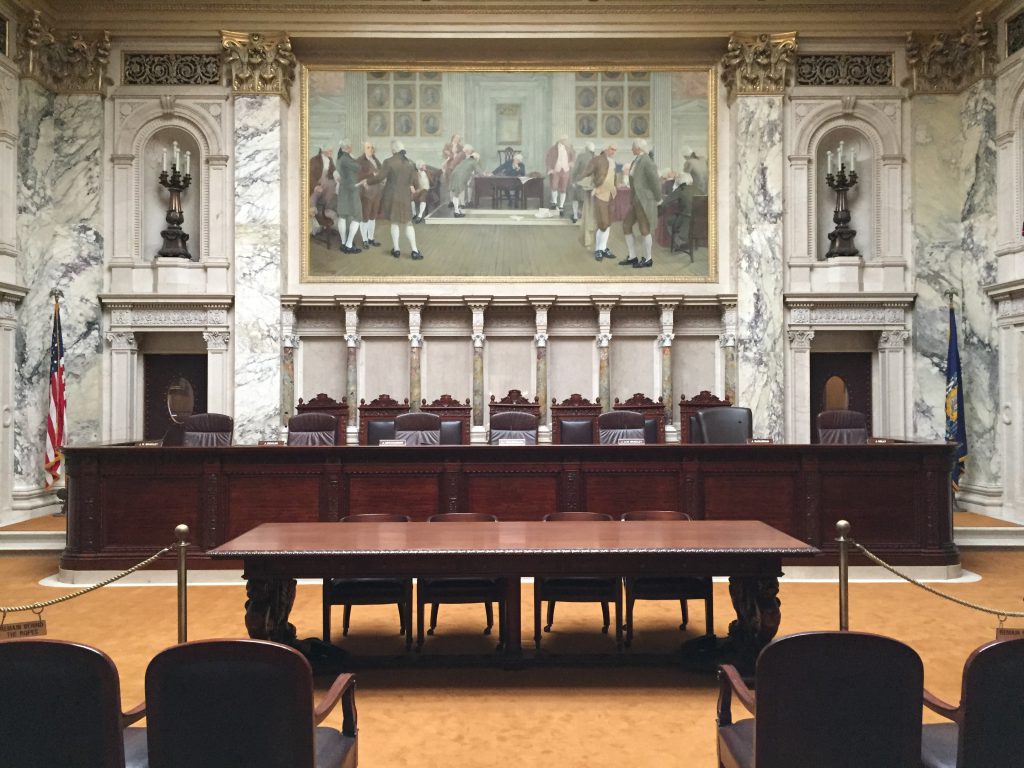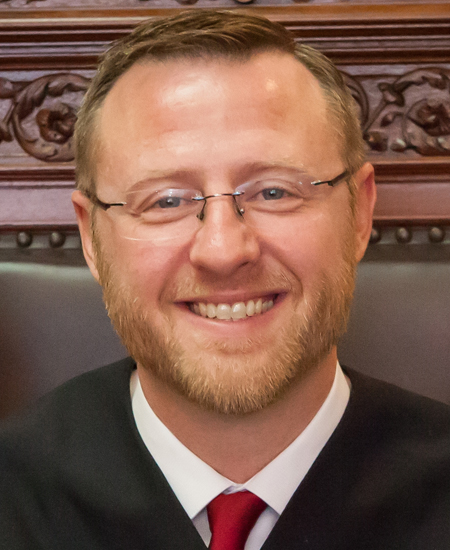Why Court Voided Evers Emergency Order
Highlights of the Supreme Court ruling — and the dissent.
This is an excerpted summary of the state Supreme Court decision overruling the COVID-19 emergency order and mask mandate by Gov. Tony Evers. No justice gets more than 10 paragraphs as written in the actual decision. The “upshot” and “background” sections do not count as part of the 10 paragraphs in the majority opinion because they summarize the case. We’ve also removed citations from the opinion for ease of reading, but have linked to important cases cited or information about them.
The case: Favick v. Evers
Majority: Justice Brian Hagedorn (27 pages), joined by Justices Rebecca Bradley, Patience Roggensack, and Annette Ziegler.
Concurrence: Rebecca Bradley (19 pages), joined by Roggensack.
Dissent: Justice Ann Walsh Bradley (29 pages), joined by Rebecca F. Dallet, and Jill Karofsky.
The Majority Decision
The Upshot
Over the last year, a dangerous new virus has spread throughout the world, disrupted our economy, and taken far too many lives. In response, Governor Tony Evers declared multiple states of emergency under Wis. Stat. § 323.10 (2019-20), triggering a statutory grant of extraordinary powers to the governor and the Department of Health Services (DHS) to combat the emergent threat. The question in this case is not whether the Governor acted wisely; it is whether he acted lawfully. We conclude he did not.
Background
At the outset, we must remember that our constitutional structure does not contemplate unilateral rule by executive decree. It consists of policy choices enacted into law by the legislature and carried out by the executive branch. Therefore, if the governor has authority to exercise certain expanded powers not provided in our constitution, it must be because the legislature has enacted a law that passes constitutional muster and gives the governor that authority.
Some may wish our analysis would focus on ensuring the Governor has sufficient power to fight COVID-19; others may be more concerned about expansive executive power. But outside of a constitutional violation, these policy concerns are not relevant to this court’s task in construing the statute…Our inquiry is simply whether the law gives the governor the authority to successively declare states of emergency in this circumstance….
The statute provides that a state of emergency “may be revoked at the discretion of either the governor by executive order or the legislature by joint resolution,” and a “state of emergency shall not exceed 60 days, unless the state of emergency is extended by joint resolution of the legislature.” These directives can be distilled into three statutory commands. First, the initial duration of a state of emergency is determined by the governor, but it “shall not exceed” 60 days. Second, a state of emergency may be cut shorter than the initial duration by either the governor through executive order or by the legislature through joint resolution. Finally, a state of emergency may be extended longer than 60 days by the legislature alone.
These are clear statutory commands, plainly stated. They compel the conclusion that the legislature enacted Wis. Stat. § 323.10’s time-limiting language to meaningfully constrain the governor’s authority to govern by emergency order….
in 2002, the legislature adopted portions of a Model State Emergency Health Powers Act (“MSEHPA”) that had been proposed in the wake of 9/11.14 These revisions…added the public health emergency to Wisconsin law. The legislature borrowed extensively from the model act in drafting these provisions, including its definition of a “public health emergency.” But the legislature did not adopt every model provision. Notably, it did not adopt the proposal to allow the governor to renew the public health emergency declaration every 30 days. Rather, it incorporated this language into its already-existing emergency declaration language with its already-existing time limitations….
We conclude that Wis. Stat. § 323.10’s duration-limiting language forbids the governor from declaring successive states of emergency on the same basis as a prior state of emergency, and that the governor may not reissue a new emergency declaration following legislative revocation of a state of emergency declared on the same basis.
Appplication:
In support of the challenged emergency declarations before us, the Governor argues the 60-day limit is no bar to multiple declarations of emergency based on the same public health emergency. Our analysis above forecloses this interpretation. But the Governor makes an alternative argument. He asserts that each declaration was supported by differing onthe-ground conditions related to COVID-19. In essence, he argues the ups and downs of COVID-19 have created independent enabling conditions thereby renewing his power to declare a new state of emergency with each new front in the fight against COVID-19. The dissent agrees. It argues that a new emergency may be declared as long as the governor drafts “a new set of onthe-ground facts.”
This approach, however, does what a proper consideration of the entire statute does not permit– it reads the duration limitations right out of the law. A governor will surely have little difficultly drafting a new emergency order stating that the challenges or risks are a little different now than they were last month or last week. So long as the emergency conditions remain, the governor would possess indefinite emergency power under this atextual theory. The more reasonable reading is that the 60-day time limit and legislative revocation power are real limitations that constrain the governor’s power to deploy emergency powers with regard to that emergency. Statutory restrictions on executive power cannot be avoided by modest updates to the “whereas” clauses of an emergency declaration.
Several times in briefing before this court, and at oral argument, the Governor suggested Wis. Stat. § 323.10’s provision giving the legislature authority to revoke a state of emergency supported his reading of the 60-day time limit as permitting renewals precisely because the legislature had an effective check. Since this case was argued, however, the legislature did revoke the state of emergency declared in Executive Order #104, only to have a new one——in Executive Order #105——immediately declared by the Governor….
As we have discussed, Wis. Stat. § 323.10 provides that an emergency declaration order “may be revoked at the discretion of . . . the legislature by joint resolution.” In order to have any effect, this provision must mean that the governor may not simply reissue an emergency declaration revoked by the legislature.18 Any other interpretation would render the legislature’s statutory power to revoke an emergency declaration illusory. The statute gives the legislature the power to override a governor’s declaration of emergency, not the other way around.
The Governor defends Executive Order #105 as different than Executive Order #104 on something he says is new – the purported loss of federal nutrition benefits——along with updates regarding the current threats presented by COVID-19. However, if an emergency declaration is a prerequisite to receiving these funds, this was no less true during the operation of Executive Order #104, which the legislature revoked. The Governor cannot make an end run around legislative revocation simply by itemizing a previously unidentified justification for the state of emergency. Reading the statute to encourage a game of whaca-mole between the governor and legislature would defeat Wis. Stat. § 323.10’s explicit legislative check on the governor’s emergency power.
Concurring Opinion
Governor Evers’ interpretation of Wis. Stat. § 323.10 as a license to unilaterally decree consecutive states of emergency based upon the same underlying cause would violate the structural separation of powers embedded in the Wisconsin Constitution, rendering the statute an unconstitutional delegation of legislative power to the executive branch….
While this case may be resolved by applying the plain language of the statute, the constitutional infirmities of Governor Evers’ interpretation of the law warrant discussion. An understanding of the structure of our government is a prerequisite to grasping the constitutional flaws in the Governor’s analysis.
The Wisconsin Constitution prohibits unlawful delegations of power among the branches as a bulwark for the people….In specifying the powers of each branch, the constitution prohibits one branch from assuming the powers of another and also forbids one branch from ceding its own powers to another….
This case concerns the legislative function, and the legislature’s authority to transfer it to another branch of government….Safeguarding constitutional limitations on the exercise of legislative power is particularly important in light of its awesome sweep….
Because the people gave the legislature its power to make laws, the legislature alone must exercise it. Our constitutional structure confers no authority on any branch to subdelegate any powers the sovereign people themselves delegated to particular governmental actors….Any laws prescribed beyond the constitutional lines of authority drawn by the people are illegitimate…
Just like the federal framework, Wisconsin’s Constitution protects against any of the three branches of government abdicating their constitutionally-vested powers….Nevertheless, this court has upheld delegations of legislative power to the executive, provided there are “adequate procedural safeguards” in place to limit executive overreach….
The Governor’s actions illustrate why this court “must be assiduous in patrolling the borders between the branches. This is not just a practical matter of efficient and effective government. We maintain this separation because it provides structural protection against depredations on our liberties….”
While some may find the limitations on the Governor’s power frustrating, particularly in the midst of a pandemic, those limitations exist to protect our liberty….
Dissenting Opinion
This is no run-of-the-mill case. We are in the midst of a worldwide pandemic that so far has claimed the lives of over a half million people in this country. And with the stakes so high, the majority not only arrives at erroneous conclusions, but it also obscures the consequence of its decision. Unfortunately, the ultimate consequence of the majority’s decision is that it places yet another roadblock to an effective governmental response to COVID-19, further jeopardizing the health and lives of the people of Wisconsin.
First, the majority errs by granting taxpayer standing to Fabick on a conjured justification neither briefed nor argued by any party. In essence, the product of this new theory results in a standard so low that all that is needed for taxpayer standing in this court is a song and a whistle with an ability to produce a melody appealing to at least four justices….
Second, the majority errs by purporting to engage in a straightforward statutory analysis. Yet, it omits any analysis of an essential word in Wis. Stat. § 323.02(16) that is outcome determinative. Left unanalyzed is the statutory term “occurrence,” which when included in the analysis, proves to undermine the majority’s conclusion and mandates a contrary result…
The majority also errs in its interpretation of the plain language of the relevant statutes, Wis. Stat. §§ 323.02(16) and 323.10. When properly focused on the actual words of these statutes, the plain language does not support the majority’s interpretation. Rather, a plain language analysis establishes that emergency declarations are permissible when, like the orders at issue here, they are based on separate statutory “occurrences,” even if those occurrences share the same underlying cause….
This is where Wis. Stat. § 323.02(16) joins the equation. Indeed, “public health emergency” is a defined term pursuant to that statute. It means “the occurrence or imminent threat of an illness or health condition that . . . [i]s believed to be caused by . . . a novel or previously controlled or eradicated biological agent.” § 323.02(16). The statute further defines a “public health emergency” as requiring that the occurrence or threat poses a high probability of either “[a] large number of deaths or serious or long-term disabilities among humans” or “[a] high probability of widespread exposure to a biological, chemical, or radiological agent that creates a
significant risk of substantial future harm to a large number of people….”
While COVID-19 may be the underlying cause of the conditions that gave rise to Orders #72, #82, and #90, the disease itself is not the statutory “occurrence” on which the orders are premised. In other words, the “occurrence” underlying each subject order is not the pandemic itself, but conditions that the pandemic has caused.
This interpretation is buttressed by the fact that an alternative “one and done” statutory interpretation, which in the main is advanced by Fabick, puts forth a position that leads to absurd or unreasonable results contrary to both common sense and recent practice.
As an illustration of the absurdity of this alternative interpretation, consider an example taken from the Governor’s brief. Imagine heavy rains leading to a flood that two months later causes a dam to break. If the governor declared a state of emergency because of the initial flooding, he could not issue another for the new flood caused by the dam failure because it shares an underlying cause with the previous state of emergency. This simply could not be the legislature’s intent….
Among the powers hamstrung by the majority are critical executive powers set forth by statute that may be exercised only in a public health emergency——powers that are essential to saving lives and getting a rapidly-spreading disease under control.
Gretchen Schuldt writes a blog for Wisconsin Justice Initiative, whose mission is “To improve the quality of justice in Wisconsin by educating the public about legal issues and encouraging civic engagement in and debate about the judicial system and its operation.”
More about the Statewide Mask Mandate
- Court Watch: Why Court Voided Evers Emergency Order - Gretchen Schuldt - Apr 5th, 2021
- Statement by Heartland Institute Director Jeré Fabick on WI Supreme Court Victory Against Gov. Tony Evers - Heartland Institute - Mar 31st, 2021
- Senator Agard: Statement on Supreme Court Decision - Dane County Executive Melissa Agard - Mar 31st, 2021
- Wisconsin’s Hyperpartisan Supreme Court is Endangering the Public - Democratic Party of Wisconsin - Mar 31st, 2021
- Wisconsin Supreme Court: Gov. Evers’ Multiple Emergency Declarations Violate Law - Wisconsin Institute for Law & Liberty - Mar 31st, 2021
- Rep. Hesselbein Statement on Supreme Court Ruling on Emergency Orders - State Senate Democratic Leader Dianne Hesselbein - Mar 31st, 2021
- Statement on Wisconsin Supreme Court Decision - State Sen. Jon Erpenbach - Mar 31st, 2021
- Gov. Evers Releases Statement Regarding Supreme Court Decision - Gov. Tony Evers - Mar 31st, 2021
- Rep. Hintz: Statement on Wisconsin Supreme Court Ruling - State Rep. Gordon Hintz - Mar 31st, 2021
- State Supreme Court Overrules Evers’ Emergency Powers - Laurel White - Mar 31st, 2021
Read more about Statewide Mask Mandate here
Court Watch
-
No Unemployment Benefits For Worker Making Homophobic Remarks
 May 17th, 2022 by Gretchen Schuldt
May 17th, 2022 by Gretchen Schuldt
-
Appeals Court Upholds Injunction Against Abortion Protester
 Mar 13th, 2022 by Gretchen Schuldt
Mar 13th, 2022 by Gretchen Schuldt
-
80% of State’s Judicial Races Uncontested
 Feb 20th, 2022 by Gretchen Schuldt
Feb 20th, 2022 by Gretchen Schuldt


























I have to say, Hagedorn’s arguments are more persuasive to me. I think even he would agree that Dallet’s dam-break analogy would be significantly unique.
Good article, saves me reading all the opinions. My interpretation is that democratic government requires checks and balances and the statute in question here is designed to do that. To suggest that by analogy that the statute means the language has a different meaning and thus the Governor has greater authority. This leads us to New York state where the excess use of executive authority highlights the issue. Checks and balances create a responsible government.
The WI Supreme Court over turned again 100 years settled law.
I found the majority opinion fairly persuasive until I read the dissenting opinion. I am quite troubled by the court’s disregard of established precedent regarding standing, and of teaching and deciding issues that were not before it for decision.